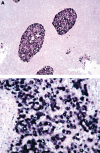Prevalence and relevance of EBV latency in nasopharyngeal carcinoma in Israel
- PMID: 14990602
- PMCID: PMC1770229
- DOI: 10.1136/jcp.2003.013094
Prevalence and relevance of EBV latency in nasopharyngeal carcinoma in Israel
Abstract
Background: Nasopharyngeal carcinoma (NPC) is frequently associated with Epstein-Barr virus (EBV). The incidence of NPC in Western countries is lower than in the Far East, and EBV latency in NPC is less prevalent. Israel, as a part of the Mediterranean area, is one of the countries with an intermediate risk for NPC.
Methods: Immunohistochemistry (IHC) for latent membrane protein 1 (LMP-1) and in situ hybridisation (ISH) for EBV encoded RNA (EBER) were used to evaluate the prevalence and possible prognostic value of EBV latency among Israeli patients with NPC. Forty five patients with different NPC histologies were studied.
Results: LMP-1 IHC was positive in six samples only, all with undifferentiated histology. EBER ISH was positive in 40 of the 45 samples. According to histological type, three of five patients with squamous cell carcinoma were EBV positive and 37 of 40 non-keratinising and undifferentiated carcinoma cases were positive. Although EBV was more prevalent in patients with non-squamous carcinoma, the difference was not significant, probably because of the small number of patients with keratinising carcinoma. With regard to the clinical categories and survival, no significant difference could be detected between patients who were positive or negative for EBER ISH. No association was found between EBV latency and patient sex, age, origin, stage, or survival.
Conclusions: NPC in Israel is highly associated with EBV latency as detected by EBER ISH. LMP-1 IHC is considerably less sensitive in detecting EBV latency in NPC among the same patient group.
Figures


Similar articles
-
Analysis of EBV latency by EBER in situ hybridization in nasopharyngeal carcinoma Spanish patients.Anticancer Res. 2001 Nov-Dec;21(6A):3921-4. Anticancer Res. 2001. PMID: 11911270
-
Epstein-Barr virus-encoded RNAs as a survival predictor in nasopharyngeal carcinoma.Chin Med J (Engl). 2014;127(2):294-9. Chin Med J (Engl). 2014. PMID: 24438619
-
Epstein-Barr virus (EBV)-encoded RNA: automated in-situ hybridization (ISH) compared with manual ISH and immunohistochemistry for detection of EBV in pediatric lymphoproliferative disorders.Pediatr Dev Pathol. 2009 May-Jun;12(3):195-9. doi: 10.2350/07-07-0316.1. Pediatr Dev Pathol. 2009. PMID: 18442302
-
[Epstein-Barr virus infection in the pathogenesis of nasopharyngeal carcinoma].Pathologe. 1998 Sep;19(5):337-44. doi: 10.1007/s002920050295. Pathologe. 1998. PMID: 9816588 Review. German.
-
Epstein-Barr virus in the pathogenesis of NPC.Semin Cancer Biol. 2002 Dec;12(6):431-41. doi: 10.1016/s1044579x0200086x. Semin Cancer Biol. 2002. PMID: 12450729 Review.
Cited by
-
Negative plasma Epstein-Barr virus DNA nasopharyngeal carcinoma in an endemic region and its influence on liquid biopsy screening programmes.Br J Cancer. 2019 Oct;121(8):690-698. doi: 10.1038/s41416-019-0575-6. Epub 2019 Sep 17. Br J Cancer. 2019. PMID: 31527689 Free PMC article.
-
CpG methylation in cell-free Epstein-Barr virus DNA in patients with EBV-Hodgkin lymphoma.Blood Adv. 2020 Apr 28;4(8):1624-1627. doi: 10.1182/bloodadvances.2020001511. Blood Adv. 2020. PMID: 32311011 Free PMC article.
-
The incidence of Epstein-Barr virus in nasopharyngeal carcinoma of Jordanian patients.Eur Arch Otorhinolaryngol. 2012 Jan;269(1):229-34. doi: 10.1007/s00405-011-1562-6. Epub 2011 Mar 16. Eur Arch Otorhinolaryngol. 2012. PMID: 21409390
-
Update in pediatric nasopharyngeal undifferentiated carcinoma.Br J Radiol. 2019 Oct;92(1102):20190107. doi: 10.1259/bjr.20190107. Epub 2019 Jul 31. Br J Radiol. 2019. PMID: 31322911 Free PMC article. Review.
-
Nasopharyngeal carcinoma in a south European population: epidemiological data and clinical aspects in Portugal.Eur Arch Otorhinolaryngol. 2010 Oct;267(10):1607-12. doi: 10.1007/s00405-010-1258-3. Epub 2010 May 8. Eur Arch Otorhinolaryngol. 2010. PMID: 20454799
References
-
- Epstein MA, Achong BC, Barr YM. Virus particles in cultured lymphoblasts from Burkitt’s lymphoma. Lancet 1964;1:702–3. - PubMed
-
- Zur Hausen H, Schulte-Holthausen H, Klein G, et al. EBV DNA in biopsies of Burkitt tumours and anaplastic carcinomas of the nasopharynx. Nature 1970;228:1056–8. - PubMed
-
- AJCC Cancer staging handbook. In: AJCC cancer staging manual, 6th ed. New York: Springer, 2002:47–61.
-
- Fandi A, Altun M, Azli N, et al. E.Nasopharyngeal cancer: epidemiology, staging, and treatment Semin Oncol 1994;21:382–97. - PubMed
MeSH terms
Substances
LinkOut - more resources
Full Text Sources
Research Materials
